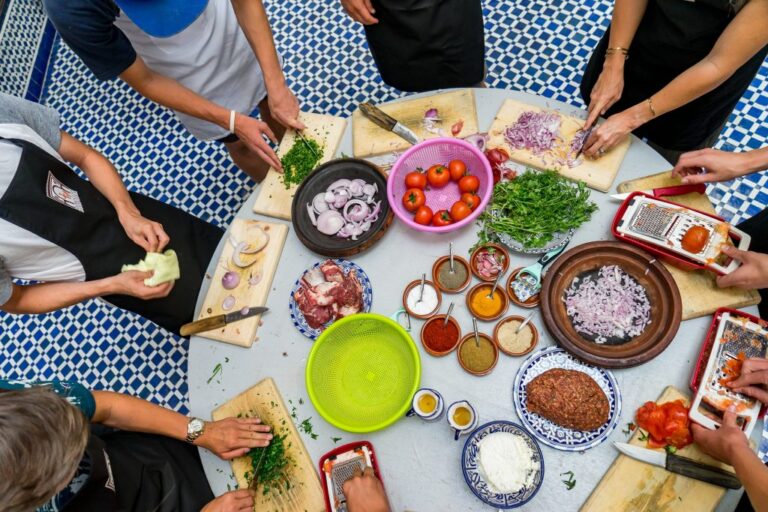Introduction: Moroccan cuisine and cultural background
Moroccan cuisine is a blend of various cultural and historical influences, with Berber, Arab, Andalusian, and French culinary traditions being the most prominent. The country’s rich and diverse geography, with its fertile plains, mountains, and coastline, also plays a significant role in shaping the cuisine. Moroccan food is known for its bold and complex flavors, with spices being an important ingredient in every dish.
In Moroccan culture, food holds a central place, and meals are often considered as a time for family and community gathering. Moroccan hospitality is also reflected in the way food is served, with guests being offered generous portions and various courses. Moroccan cuisine is typically eaten with hands, and bread is often used to scoop up stews and sauces.
Islamic dietary rules and their impact on Moroccan cuisine
The majority of Moroccans are Muslims, and Islamic dietary rules, known as Halal, significantly influence Moroccan cuisine. Halal refers to permissible food and drinks according to Islamic laws, and it prohibits the consumption of pork, alcohol, and any animal products that are not slaughtered in the name of Allah.
Halal meat is a crucial aspect of Moroccan cuisine, and it is readily available in markets and restaurants. The meat is often slow-cooked with spices and served with vegetables and couscous or bread. In contrast, non-Halal meat, such as pork, is not consumed in Morocco. Islamic rules also dictate that meat must be cooked separately from dairy products, and utensils used for cooking meat cannot be used for dairy dishes.
The role of meat in Moroccan cuisine: halal and non-halal
Moroccan cuisine is known for its meat dishes, with beef, lamb, and chicken being the most commonly consumed. These meats are often used in stews and tagines, which are slow-cooked dishes with vegetables and spices. Camel meat is another delicacy in Morocco, mainly consumed in rural areas.
Non-Halal meat, such as pork, is not consumed in Morocco due to Islamic dietary rules. However, seafood is a popular alternative, being widely available due to Morocco’s extensive coastline. Fish dishes, such as grilled sardines or seafood tagine, are common in coastal regions.
Vegetarian and vegan options in Moroccan cuisine
Moroccan cuisine also offers a variety of vegetarian and vegan options, with vegetables being a staple ingredient. Tagines and stews can be made with a wide range of vegetables, such as eggplants, carrots, tomatoes, and zucchini. Chickpeas and lentils are also commonly used in Moroccan dishes, such as Harira, a hearty soup traditionally consumed during Ramadan.
Moroccan salads are another popular vegetarian option, with a variety of fresh ingredients such as tomatoes, cucumbers, and olives, mixed with herbs and spices. Moroccan cuisine also offers vegan options, such as Batbout, a type of bread that is typically filled with vegetables or herbs.
Common ingredients and spices used in Moroccan dishes
Moroccan cuisine is known for its bold and complex flavors, with spices being a crucial ingredient. Ras El Hanout, a spice blend that can contain up to 30 ingredients, is a staple in Moroccan cooking. Other common spices used in Moroccan dishes include cumin, paprika, ginger, turmeric, and saffron.
Fresh herbs, such as parsley, cilantro, and mint, are also used extensively in Moroccan cuisine, adding a fresh and fragrant touch to dishes. Olives and preserved lemons are other essential ingredients in Moroccan cooking, adding a salty and tangy flavor to stews and tagines.
Regional variations and dietary customs in Morocco
Morocco’s regional variations and diverse cultural influences also impact dietary customs. For instance, in the Rif region in the north, goat meat and dairy products are commonly consumed, while in the south, camel meat is popular. In the coastal regions, seafood is a staple ingredient, while in the Atlas mountains, Berber cuisine is prevalent, focusing on grains, legumes, and vegetables.
During Ramadan, the month of fasting for Muslims, Moroccan cuisine takes on a particular significance, with special dishes prepared for the breaking of fast. Harira, dates, and Chebakia, a sweet pastry, are commonly consumed during Ramadan. Moroccan cuisine is a reflection of Morocco’s rich culture and history, and dietary customs and restrictions play a significant role in shaping the cuisine.

